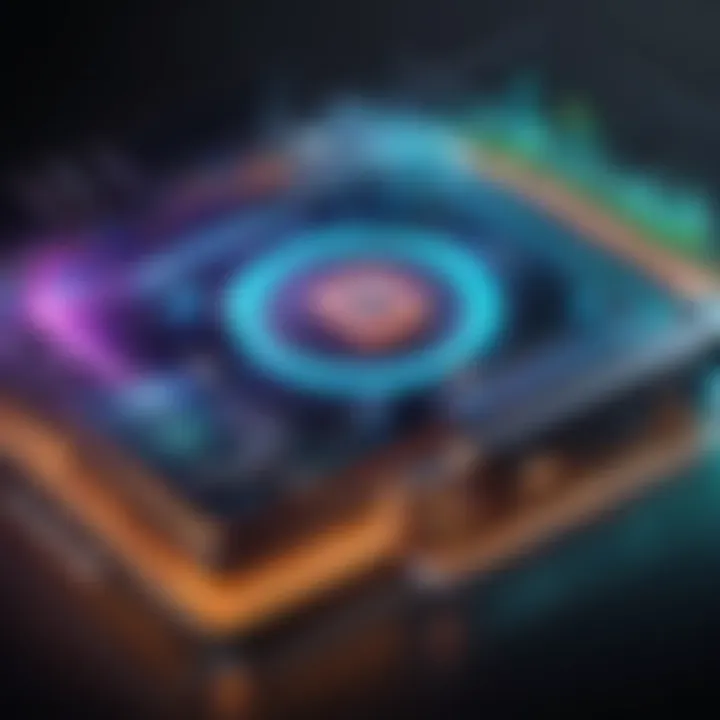Maximize Your Xbox Ping: Essential Tips for Gamers


Intro
When it comes to gaming on Xbox, latency—or ping—can be a real deal-breaker. The thing is, high pings can turn those epic gaming moments into frustrating experiences. Imagine you’re in a tense match, and your actions are lagging behind. That’s like running a marathon in slow motion while everyone else zooms past you.
In this guide, we ain't just scratching the surface. We'll dig deep into the heart of what affects your ping and how to optimize it—like finding the right tools to fine-tune a racing engine. Whether you’re battling it out in fast-paced shooters or exploring vast open worlds, getting that ping in check can make a world of difference.
So, what's on the agenda? We will cover various aspects, from adjusting your network settings to selecting the perfect gear. Let’s roll up our sleeves and get into the nitty-gritty, ensuring your Xbox runs smoother than a well-oiled machine.
Understanding Ping and Its Importance for Gaming
Understanding ping is crucial for anyone deep into online gaming, especially on platforms like Xbox. It helps players gauge the performance of their online sessions and is a key component in creating an enjoyable gaming experience. Ping, in its essence, measures the time it takes for data packets to travel from your device to a server and back. Low ping means quicker responses and less lag, which can be the difference between winning and losing.
In gaming, the importance of low ping cannot be overstated. If you're trying to tackle another player in a high-stakes match, every millisecond counts. A high ping often results in frustrating delays that can hinder communication with teammates or slow down your reactions during critical moments. Such delays translate to a less enjoyable experience, and let's face it – nobody wants to feel like they're playing in slow motion when their opponents are zipping around.
What exactly constitutes a good ping rate? Ideally, a ping under 20 milliseconds is considered excellent, while anything below 50 milliseconds is generally acceptable for online gaming. Once you start creeping above 100 milliseconds, you might notice a significant drop in gameplay performance.
"A low ping can transform your gaming experience from mediocre to top-tier, allowing for seamless interaction and responsive gameplay."
It's not just the competition aspect; even casual gaming benefits from low ping. With smooth graphics and quick load times, you can immerse yourself in the game rather than battling with lag. Understanding ping and targeting a lower rate should sit high on your priority list when setting up your gaming environment. Achieving that means exploring various facets of your network setup, and that’s exactly what we will investigate throughout this guide.
Factors Influencing Ping on Xbox
When you game online, ping can be the unsung hero or your worst enemy. Understanding the factors that influence ping is crucial, especially if you’re an avid Xbox enthusiast. It’s not just about your reflexes or strategy; it’s also about how quickly your actions are reflected in the game. Let's break it down.
Network Type: Wired vs. Wireless
The debate between wired and wireless connections has been ongoing in the gaming community, and with good reason. A wired connection typically offers more stable latency and lower ping rates than a wireless one. Why’s that? Wired connections, like Ethernet, have less interference and can maintain consistent speeds, giving you the edge in fast-paced games where every millisecond counts.
On the other hand, wireless connections introduce unpredictable variables. Wi-Fi signals can be affected by obstacles, distance, and even the presence of other devices. If you choose to go wireless, consider this: try to be as close to the router as possible, and make sure there aren't walls blocking the signal. In most cases, if you can hard-wire your Xbox to the router, it’s worth the trouble.
ISP Quality and Server Locations
Your Internet Service Provider (ISP) plays a significant role in how your ping performs. Some ISPs might provide blazing fast speeds for downloads, but when it comes to latency, they come up short. Look for an ISP that offers low-latency connections. This could mean the difference between being shot right when you pull the trigger or landing that headshot at the last possible moment.
Moreover, where the game servers are located matters too. If the servers you connect to are located far away from your home, you can expect higher ping. Always choose a game server closest to you if given the option; the effect on your gameplay is noticeable. The shorter the distance your data has to travel, the lower your latency.
Latency Sources: Internal and External
Latency isn’t just about your connection to the internet; it also has layers. Internal latency can arise from devices connected to your network. Too many devices sharing bandwidth creates a bottleneck, causing delays in packet delivery. For instance, if your Xbox competes with a family member streaming movies, your ping might take a hit. Consider limiting bandwidth usage during your gaming time by managing schedules or optimizing devices that consume a lot of data.
On the flip side, external latency sources can include the overall internet traffic and the existing infrastructure. High traffic during peak hours may slow down your connection. In certain areas, poor cabling or outdated networking equipment can lead to further delays. Taking inventory of your network equipment and understanding when peak usage times occur can help mitigate these effects.
"Optimizing your network settings and understanding your environment can make a substantial difference in your gaming experience."
In summary, knowing these factors lets you prepare better for gaming sessions. Whether it's switching to a wired connection, choosing the right ISP, or managing your local network effectively, every little tweak you make can bring you closer to that sweet low-latency nirvana.
Essential Networking Equipment
When it comes to reducing ping and enhancing your online gaming experience on Xbox, the right networking equipment cannot be overstated. Without stepping into top-tier tech jargon, let’s lay it all out – the components of your network can make a world of difference.
Quality networking gear not only boosts reliability but can also optimize performance in ways that gamers might not notice at first glance. Think of networking equipment as the unsung heroes of your gaming setup.
Choosing the Right Router


Selecting the right router acts as the main port of call for your gaming connection. It’s like picking the right vehicle for a cross-country trip; it needs to be reliable and get you to your destination without hiccups. A powerful router ensures smoother gaming sessions because it handles data traffic more effectively.
So, what should you look for?
- Dual-Band Capability: Modern gaming demands bandwidth, and a dual-band router offers both 2.4 GHz and 5 GHz bands. This means less interference, which can be a game changer for those intense multiplayer matches.
- Speed Ratings: The labeled speed is crucial. You see those numbers like AC1200 or AC1900 - they indicate performance capabilities. Higher ratings can handle more devices without slowing down.
- Security Features: An increasingly important factor these days. Built-in protections help safeguard against data breaches, so you can game without worry.
Network Extenders and Boosters
Now, what if you’ve already got a decent router but still struggle with connectivity? Network extenders and boosters come into play. These devices amplify your existing Wi-Fi signal, extending the reach to hard-to-reach corners of your home.
- Wi-Fi Extenders: They take your existing signal and repeat it. Imagine having a friend hold out their hand to pass a note across a long table. The extender does the same for your data packets.
- Mesh Networks: A series of interconnected devices create a blanket of coverage. It’s like having multiple friends along that table, all willing to help make things easier.
"In a world of gaming, a solid network connection is as vital as quick reflexes."
Quality of Service (QoS) Settings
Finally, let’s not overlook the settings on your router. Quality of Service (QoS) is a feature that allows you to prioritize your gaming traffic over others. Imagine being the captain of a ship; you're steering where the waves go instead of the waves tossing you around.
- Prioritizing Gaming Traffic: By adjusting your QoS settings, you can ensure that your Xbox receives the bandwidth it needs, especially if there are other devices hogging the internet.
- Configuring for Optimal Performance: Different games might require different settings. Some are more sensitive to latency than others, and you can configure your router settings accordingly.
Optimizing Xbox Network Settings
When it comes to gaming on your Xbox, ensuring a smooth and responsive online experience is paramount. One of the main tasks to achieve this is optimizing your Xbox network settings. This process influences your gaming performance directly. A well-optimized setup can mean the difference between victory and defeat, especially in competitive scenarios where every millisecond counts. Your network settings affect not just the speed of your connection, but they also shape how devices communicate with your Xbox.
Configuring DNS Settings
The Domain Name System, usually referred to as DNS, acts as the phone book of the internet. It translates friendly domain names into IP addresses, letting your console connect to online services. Choosing the right DNS settings can significantly impact your gaming experience.
A quick adjustment can be made by switching to public DNS services, such as Google (8.8.8.8 or 8.8.4.4) or Cloudflare (1.1.1.1). This often leads to faster response times because these services are optimized for speed and stability, reducing the time your Xbox takes to reach gaming servers. To configure DNS settings on your Xbox:
- Press the Guide button on your controller.
- Navigate to Settings > Network > Network settings.
- Choose Advanced settings and then select DNS settings.
- Switch to Manual and enter the DNS addresses.
Using public DNS could improve your overall connection stability, which is worth considering.
Changing NAT Type
A Network Address Translation (NAT) type affects how your Xbox communicates with the internet. NAT facilitates the communication between your console and the game servers, influencing both performance and connectivity. There are three types of NAT: Strict, Moderate, and Open. An Open NAT type offers the best gaming experience.
To change your NAT type, you may need to adjust port forwarding on your router. Here’s how:
- Access your router settings via a web browser, usually by inputting the router’s IP address.
- Find the section dedicated to port forwarding and input the required ports. For Xbox live gaming, primary ports include 3074 (UDP and TCP).
- Save the changes and reboot your router.
An Open NAT allows better matchmaking possibilities and less chance of connectivity issues while gaming, thus giving you an edge over others.
Adjusting IPv4 and IPv6 Settings
Your Xbox can operate using either IPv4 or IPv6 protocols. While IPv4 is the traditional protocol, IPv6 is newer and can offer benefits such as easier allocation of IP addresses and potentially lower latency. Switching between these can yield different results based on your network environment.
To adjust these settings:
- Go back to the Network settings on your Xbox console.
- Under Advanced settings, check if your console is currently using IPv4 or IPv6.
- If using IPv4 causing issues, try switching to IPv6 by changing the settings in your router as well.
The effectiveness of this adjustment can vary based on your Internet Service Provider. In some cases, enabling IPv6 may lead to better latency and more stable connections for online gaming.


Adjusting your Xbox network settings optimizes your online gaming experience, reducing lag and increasing responsiveness.
Environmental Considerations
When we talk about enhancing ping rates for Xbox gameplay, it’s easy to overlook the role of the environment in the equation. Yet, various environmental factors can greatly affect your online gaming experience. From the physical setup of your console to the presence of electronic interferences, these considerations can make or break your gaming sessions.
Positioning the Xbox Console
The placement of your Xbox console is not just a matter of aesthetics—it plays a crucial role in reducing latency and improving connectivity. Ideally, your console should be situated in a well-ventilated area, away from walls and obstructions. A good practice is to place it on a hard surface rather than a carpet, as soft materials can trap heat and potentially suffocate the device’s cooling system.
Moreover, distance from the router matters a lot. The further away your console is from the router, the weaker the signal typically is. If your setup allows, position the Xbox within a short range of your Wi-Fi source to maintain a strong connection.
"Sometimes, it’s the little things in your setup that can lead to improved performance. A simple move can make all the difference."
Additionally, keep your console away from other electronic devices that can interfere with the signal, such as microwaves and cordless phones. Not only do they emit electromagnetic waves, but they can also disrupt Wi-Fi signals, leading to lag during critical gaming moments.
Reducing Interference from Other Devices
In our tech-savvy homes, multiple devices often compete for internet bandwidth. Smartphones, tablets, smart TVs—each plays a role in the online connectivity landscape. To keep your Xbox performance at its peak, it’s advisable to limit the number of devices sharing the same network while gaming. If you can, pause updates or downloads on other devices during your gaming sessions; this can help free up precious bandwidth.
Consider these strategies to minimize interference from other devices:
- Use Wired Connections: If possible, connect your Xbox directly to the router using an Ethernet cable. This not only reduces interference but also provides a more stable connection.
- Set Up Guest Networks: Many routers allow you to create guest networks that can limit bandwidth for other users. Consider this to prioritize your Xbox's connection.
- Prioritize Bandwidth: Check if your router offers Quality of Service (QoS) settings. This allows you to allocate more bandwidth to your Xbox during gameplay.
Monitoring Ping and Network Performance
Monitoring ping and network performance is like checking the oil in your car; it’s crucial for ensuring everything runs smoothly. In gaming, especially on platforms like Xbox, having a low ping isn't just a luxury—it’s a necessity. Everyone's had that moment, whether in a shooter or an MMORPG, where a split-second delay can mean the difference between victory or defeat. Low latency not only leads to a better gameplay experience but also fosters a more engaging and competitive environment.
Keeping an eye on your ping allows you to identify issues before they spiral out of control. Regular monitoring can help you spot spikes in latency that could disrupt your gaming sessions. When you keep track of how your connection performs, you’ll be better equipped to make informed decisions about adjusting your settings or even troubleshooting hardware problems.
Benefits of monitoring your ping and network performance include:
- Early Identification of Issues: Regularly checking your ping can alert you to problems before they significantly impact your gameplay.
- Understanding Network Trends: Observe patterns in connection quality. Do you notice lag during certain times of the day? This information can inform your gaming schedule.
- Improved Gameplay Experience: With lower ping rates, you'll experience smoother control, faster reactions, and overall a more cohesive gaming experience.
Tools for Testing Ping
To truly understand the state of your network, using tools for testing ping is essential. These tools can help you assess how stable and fast your connection is, allowing you to make appropriate adjustments.
A few reliable tools to consider include:
- PingPlotter: This tool provides detailed graphical representations of your ping over time, allowing you to see where problems might be occurring.
- WinMTR: A combination of ping and traceroute. This software monitors your connection to a specific server and highlights any dropouts or high latency at each hop.
- Xbox Networking Test: Built directly into the Xbox interface, it shows you latency, packet loss, and other essential connection metrics.
Using these tools regularly can provide insights into your network that might not be visible without a deeper analysis.
Interpreting Ping Test Results
Now that you’ve got the data, what do you do with it? Interpreting ping test results is key to understanding your network performance. Generally, ping results are displayed in milliseconds (ms). The lower the number, the better the connection.
- 0-20 ms: Excellent—your connection is almost instantaneous, ideal for competitive gaming.
- 20-50 ms: Good—most games will feel smooth, and lag should be minimal.
- 50-100 ms: Fair—some noticeable lag may occur during fast-paced gaming.
- Over 100 ms: Poor—you can expect significant delays, making it nearly impossible to play effectively.
Also, look for any patterns or anomalous spikes in your ping. For instance, if you see unusually high ping during specific times or moments while playing, that could signal a need for further investigation.
"When it comes to gaming, strategy is just as important as hardware. Monitoring your connection is the foundation upon which all success is built."


By deciphering your ping test results, you can adapt your gaming habits or make necessary adjustments, whether through fine-tuning settings, upgrading equipment, or even speaking with your ISP for support. This ability to critically analyze your performance can lead you to gameplay that is not only more enjoyable but consistently high-quality.
Troubleshooting Common Connectivity Issues
In the realm of online gaming, having a smooth and uninterrupted experience is paramount. Having connectivity issues can lead to disruptions that not only frustrate players but also significantly impair game performance. This section will delve into the nuances of troubleshooting common connectivity problems on Xbox, helping gamers diagnose and resolve issues effectively. By understanding the types of connectivity issues one might encounter, players can take informed steps to rectify them, translating to a more enjoyable gaming experience.
Identifying and Resolving Lag Problems
Lag can feel like an unwelcome guest, creeping in when you least expect it. It's that annoying delay between your inputs and the game's response, making it seem like you're a step behind. There are several reasons why lag pops up, but often, it’s due to a poor connection or network congestion.
To tackle lag, start by assessing your network's performance. Run a speed test to get a benchmark of your current download and upload speeds, as well as your ping. If you notice that your ping times are sky-high, it's time to roll up your sleeves and diagnose the issue.
- Check your connection type: If you're using wireless, consider switching to a wired Ethernet connection. This usually yields a more stable environment.
- Minimize bandwidth usage: Ensure no other devices on your network are hogging bandwidth. Streaming movies or large downloads can dramatically increase latency.
- Game server issues: Sometimes, the problem isn't on your end. Check online forums or social media platforms like Reddit or Facebook to see if others are experiencing similar issues with their connections.
- Update your hardware and software: Outdated routers or consoles can struggle to keep up with newer technology. Ensure your Xbox and gaming software are up to date, as compatibility plays a key role in performance.
By systematically checking these aspects, you can often track down the source of lag and apply the necessary fixes.
When to Contact Your ISP
Sometimes, despite your best efforts, the connectivity issues persist. That’s the time to consider reaching out to your Internet Service Provider (ISP). Don't hesitate; they exist to help you navigate these tricky waters!
Here are a few scenarios where contacting your ISP might be warranted:
- Consistently high latency: If you regularly notice ping times soaring past acceptable thresholds, it's a signal that your ISP should be informed. They can provide insight into whether the issues stem from their end or an overload in the local area.
- Frequent disconnections: If your connection drops more often than a hot potato, it’s a sure sign to give your ISP a call. They can run diagnostics to pinpoint whether it’s a line issue or something else entirely.
- Promised speeds not matching reality: If you’ve subscribed to a plan that guarantees certain speeds but consistently receive much less, talking to customer support can often yield results. Sometimes, they can even offer upgrades or a better package for your needs.
In reaching out, be prepared to provide them with detailed information including your speed tests, any previous troubleshooting steps you’ve undertaken, and your networking setup. This can tremendously speed up the process of finding a resolution.
"The first step in resolving a connectivity issue is acknowledging it exists."
By being proactive when it comes to identifying and addressing lag problems, as well as knowing when to engage your ISP, you'll create a foundation for a significantly improved gaming experience on Xbox. A little diligence can go a long way in ensuring smooth gameplay, keeping frustration at bay.
Future Trends in Gaming Network Technology
The gaming landscape is evolving at a breathtaking pace, and with it, the technology that supports online gaming is also making big leaps. Understanding these future trends in gaming network technology is crucial, especially for players on Xbox, since these developments can greatly impact ping and overall gaming experience. Today's gamers are not just looking for any old connection; they demand speed, reliability, and low latency. Addressing these demands means staying ahead of the curve.
5G and Cloud Gaming
Faster mobile networks are on the horizon, and 5G technology is leading this charge. With its higher bandwidth and lower latency compared to previous generations, 5G opens the door for seamless gaming experiences. Imagine an online match that feels as responsive as local play, regardless of your physical distance from the server.
Cloud gaming is another game-changer, transforming how gamers access and play their favorite titles. Instead of relying heavily on local hardware, games are processed in remote data centers and streamed to players’ devices. This technology is particularly beneficial for folks who don’t want to invest in high-end consoles or PCs. However, this shifts some dependence to internet connectivity.
- Benefits of 5G and Cloud Gaming:
- Lower latency for smoother gameplay
- Allows for larger multiplayer sessions with minimal lag
- Reduces the need for expensive gaming hardware
Despite its potential, there are considerations, such as the infrastructure development in various regions and the need for players to have strong and stable internet connections to fully experience these advancements.
In places where 5G is still rolling out, consistent connectivity could remain a challenge, leading to mixed experiences in cloud gaming.
The Role of AI in Network Optimization
Artificial Intelligence is becoming a cornerstone in enhancing network performance. AI tools can dynamically analyze network conditions and adjust settings to minimize ping. For instance, AI-driven software can identify bottlenecks, prioritize gaming traffic over other data, and even customize routes within the network to ensure a stable experience. This technology can make all the difference between a frustrating lag and a smooth-playing session.
- Key Advantages of AI in Network Settings:
- Optimizes bandwidth usage effectively
- Detects and mitigates potential issues before they impact gameplay
- Enhances overall system performance in real time
Moreover, AI can help in predicting potential connectivity issues based on player behavior or environmental changes. As knowledge expands on network optimization guided by AI technologies, the hope is for consistently smooth gaming experiences.
"The future of gaming is not only in the capabilities of the console but in the way we connect to each other and the games we love."







